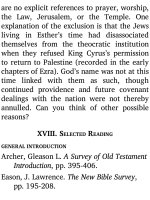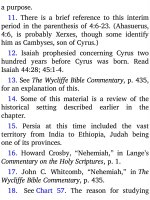Jensens survey of the old testament adam 101
Bạn đang xem bản rút gọn của tài liệu. Xem và tải ngay bản đầy đủ của tài liệu tại đây (117.91 KB, 4 trang )
in favor of Ruth.
3. As it turned out, the nearest kinsman
wanted the land (4:4b) but not Ruth, and so
he would not gain by the transaction. Boaz
wanted Ruth, not the land, and had the
money to transact the business. (Read the
following references to a kinsman and his
right to redeem: Lev 25:25-31, 47-55; Deut
25:5-10; Job 19:25.)
Redeemer. In view of the above
description, it may now be seen why Boaz is
called a kinsman-redeemer. The two words
are essentially synonymous, but the word
“redeemer” is added since our English word
“kinsman” usually suggests only the idea of
family relationship. Notice the seven
occurrences of the word “redeem” in
chapter 4. It translates the same Hebrew
root as gô-ēl.
C. MESSIANIC TYPES
Since we now have the New Testament
with its antitypes (antitypes are the
ful llments of the types), it is usually not
too di cult to identify types which reside in
various persons, things, and events of Old
Testament history. (Note: In a study of
types, one should always be careful to make
the antitype, not the type, the preeminent
fact; and also to avoid forcing types for the
mere sake of typology.)
There is a rich underlying typology in the
book of Ruth. The major groups are
described below.
1. Ruth, representing the Church, the body of
believers. Follow this theme through from
Ruth’s lost condition in chapter 1 to her
salvation in the later chapters. G. Campbell
Morgan suggests an outline: The Choice of
Faith (1-2); The Venture of Faith (3); The
Reward of Faith (4)9
2. Boaz, representing Christ, the KinsmanRedeemer. Gleason L. Archer says that “the
little book of Ruth is one of the most
instructive in the Old Testament concerning
the mediatorial work of the Lord Jesus.”10
He cites some of the quali cations and
functions of the go-ēl.
a) He must be a blood relative.
b) He must have the money to purchase the
forfeited inheritance.
c) He must be willing to buy back that
forfeited inheritance.
d) He must be willing to marry the wife of a
deceased kinsman.
Pursue this study further, observing how
Christ as the believer’s Kinsman-Redeemer
fulfills the above qualifications.
D. GENEALOGY OF THE MESSIAH
The concluding verses (4:17-22) of the
book of Ruth are very signi cant, for, as one
writer has said, “a genealogy is a striking
way of bringing before us the continuity of
God’s purpose through the ages.”11 As to
the uniqueness of this particular genealogy,
A. Macdonald comments:
The reader is here constrained to face
the vital matter that is behind the
story, namely the genealogy of the
Messiah, for every Israelite knew that
the Messiah was to spring from David.
Ruth the Moabitess is seen no longer as
the courageous stranger who came to
Bethlehem, but as the woman whose
great love for Naomi and devotion to
Naomi’s God put her into the direct
line of the Messiah.12









